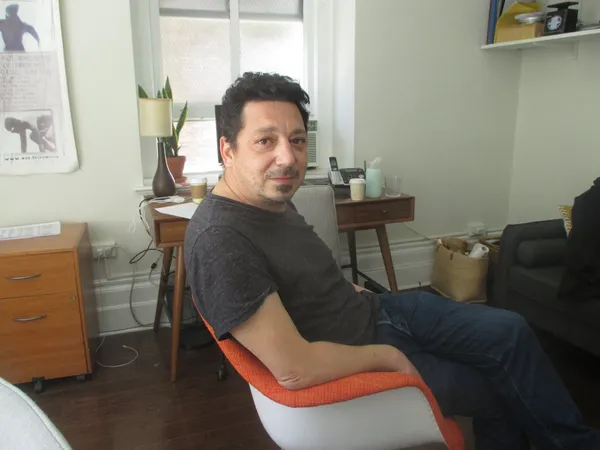 |
| Walking On Water director Andrey Paounov on Christo: "Every one of his projects is like a small art war. I find it extremely fascinating. Just for cinema this is incredible." Photo: Anne-Katrin Titze |
Walking On Water, directed by Andrey Paounov and edited with Anastas Petkov, produced by Izabella Tzenkova (Crystal Moselle's The Wolfpack, Skate Kitchen) and Valeria Giampietro, captures the creation of Christo's Floating Piers at Lago d'Iseo in Northern Italy, and the creator at war with himself and those around him in an intimate and public in-your-face way.
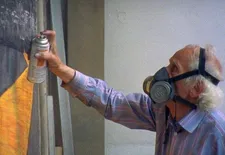 |
| Andrey Paounov: "It's all about character and character development and really trying to sculpt this piece that allows you to kind of walk into Christo's shoes." |
In my conversation with Andrey Paounov we start with the emotional journey Christo ignites as he tries to get The Floating Piers off the ground and onto a body of water. Vladimir Yavachev, a relentless driving force on the project, was the director's initial connection. Andrey discusses his first fiction film, which he notes is a Samuel Beckett Waiting For Godot meets Stanley Kubrick's The Shining, and we touch on Christo's Walking On Water Brexit moment in the second installment.
Anne-Katrin Titze: "This is a horror story" is a quote from the beginning of your documentary. You show Christo very upset. Is it a horror story?
Andrey Paounov: No, he just gets emotional. That's part of it. He just explodes sometimes. He's this way, he's an artist.
AKT: I like that you show so many facets. Not many documentaries about artists do that. You didn't seem to want a smooth image for PR purposes.
AP: The original idea was not to make an art documentary. I know nothing about art. I'm interested only in human beings. I was interested to shape three-dimensional characters out of the footage. It's a cocktail, no human is black and white.
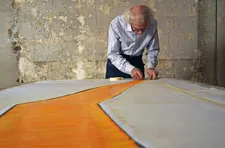 |
| Andrey Paounov on Walking On Water: "You can still do storytelling and a lot of times you don't need words for that." |
AKT: It's definitely a cocktail. And there are other humans as well. There is Vladimir [Yavachev] who is almost as important as Christo himself in the film. How did it come about? Did you know each other before?
AP: I knew Vladimir from before. I was actually present on the project just as a guest, as a visitor. As Christo's projects are so ephemeral and disappear in two weeks, they are very heavily documented. At the end of the project he ended up with 750 hours of footage that was shot randomly by different crews covering different aspects of the project and following the main protagonists. I was approached by the producers [Valeria Giampietro and Izabella Tzenkova] and Vladimir with the idea to scout footage and see if we can shape a film out of it.
AKT: So the footage is from all different kinds of people?
AP: Yes. Then in the process, I continued filming with Christo and following his adventures around the world. We also did significant research and we found extra stuff on YouTube and people's cellphones, everything, to build this world.
AKT: It surprises me, because it feels very together.
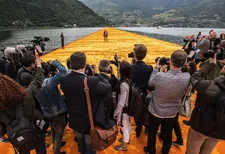 |
| Christo on The Floating Piers out on Lago d'Iseo: "How fragile and emotional it is. You just go there as a spectator and you don't realise." |
AP: It's one year editing.
AKT: The editing is it. The glances, for instance. I'm thinking about the provincial board meeting in Italy. You don't even bother with subtitles, you simply show the exhausted look on Vladimir's face and Christo's face. They are half there, half elsewhere. The faces are the focus.
AP: Yeah, the process of this film was much closer to fiction filmmaking. It's not a film that was preoccupied with information. It's all about character and character development and really trying to sculpt this piece that allows you to kind of walk into Christo's shoes.
AKT: And show the world he operates in. We see him in the beginning with heads of state and all kinds of people repeating the same thing over and over again - walking on water, walking on water. You see what it takes, how much repetition to get a project underway.
AP: Yes. I think it's a very good representation of the behind-the-curtain of Christo's world. It's not about what everybody has seen, it's all about the kitchen of art.
AKT: The Italian art buyer, who stays unidentified, who makes comments such as "Italians and Bulgarians - there's no hope" and gestures of hanging himself - you don't want to talk about him?
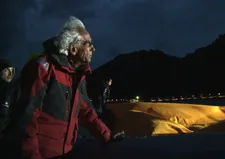 |
| Christo on Lago d'Iseo night patrol: "It's at the foot of the Alps and even in the summer it can be quite rough." |
AP: Let's put it this way, when I started approaching the footage and found in this big mayonnaise of hundreds of hours, I found these little pieces. And then I showed some to Christo and said "Listen, I think this is really fascinating, this is really incredible. But we have to talk if any of this being in a film would bother you."
And it was exactly the opposite. Christo was like so excited about it and said, "Wow, we can actually show how it is." He was really into that. That's probably the reason why this film actually came about. The other is his fantastic sense of self-irony and humour that Christo has.
AKT: It's a very funny film. I was laughing many times during the screening. A sequence that is super telling is the VIP reception on the island. It is so recognizable and cringeworthy. The endless parade of sameness and photo taking. I love the editing at this spot. They take first a selfie with him and next with the hambone. Christo and the hambone become the same.
AP: These are the things that make me very excited about documentary because you can on the one side stay in the everyday and you draw on reality and at the same time you can sculpt it. You can still do storytelling and a lot of times you don't need words for that. These are situations we are familiar with, we know how to read their codes.
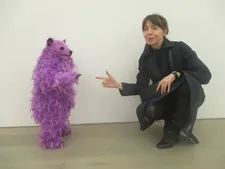 |
| Paola Pivi's We Are The Baby Gang member with Anne-Katrin Titze at the Perrotin Gallery in New York Photo: Ed Bahlman |
AKT: The weather is starring, of course, in Christo's work. You have a kind of meteorological thriller going in the middle. Is the thunderstorm ruining it all? Were you there at Lago d'Iseo at that time?
AP: No, but I was there when there were storms all the time. It's at the foot of the Alps and even in the summer it can be quite rough.
AKT: You see all this work that went into it and it all could fail because of the unpredictable weather. That shows you the fragility.
AP: How fragile and emotional it is. You just go there as a spectator and you don't realise. For me Christo has his own warfare. Every one of his projects is like a small art war. I find it extremely fascinating. Just for cinema this is incredible. How many artists can you follow and have such an incredibly dramatic visual tale?
AKT: Recently, I was at the reception for the exhibition of Paola Pivi's We are the baby gang. She makes these incredible polar bears with feathers. It's great, they are wonderful and make you laugh and think about climate change and the loss of species in the natural world. But it's safe. They are in a gallery. Unlike Christo, she doesn't need to be concerned with the wavering weather reports.
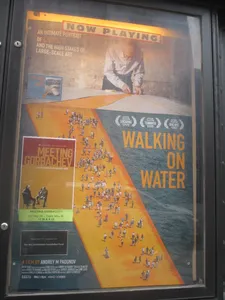 |
| Walking On Water poster at Film Forum in New York Photo: Anne-Katrin Titze |
AP: One of the first things I learned about Christo when I met him was that for him the work of art is the combination of all those things, all these emotions, all this madness. All the different problems that occur that he and his team have to overcome, this is the work of art.
AKT: The helicopter ride, is that such a nightmare for him?
AP: Yes.
AKT: I was on a small plane with him and Jeanne-Claude once. It was a terribly bumpy flight from Basel to Berlin. I remember thinking, okay, I'm going to die on a plane with Christo.
AP: You know, they used to fly always in different planes. And then they would take the same taxi. He has this fear.
Coming up - Andrey Paounov on finding a good balance, Christo's eyelashes, a Barbour jacket, raw eggs, Brexit, and Beckett meets The Shining.
Paola Pivi's We are the baby gang at the Perrotin Gallery in New York runs through June 6.
Walking on Water is in cinemas in the US.





















